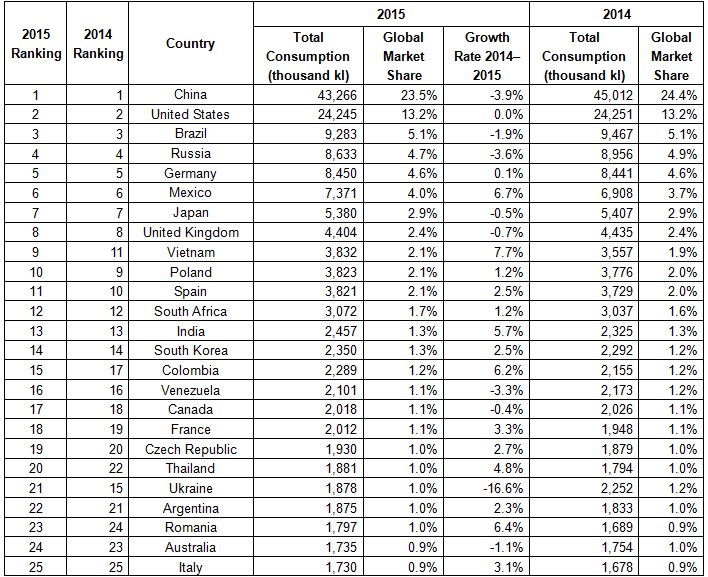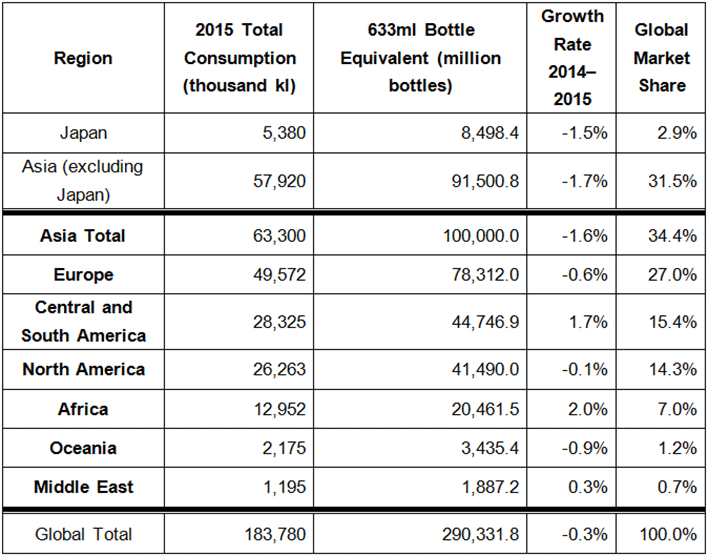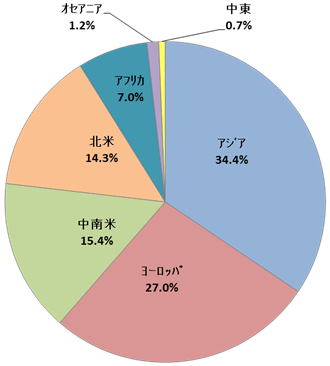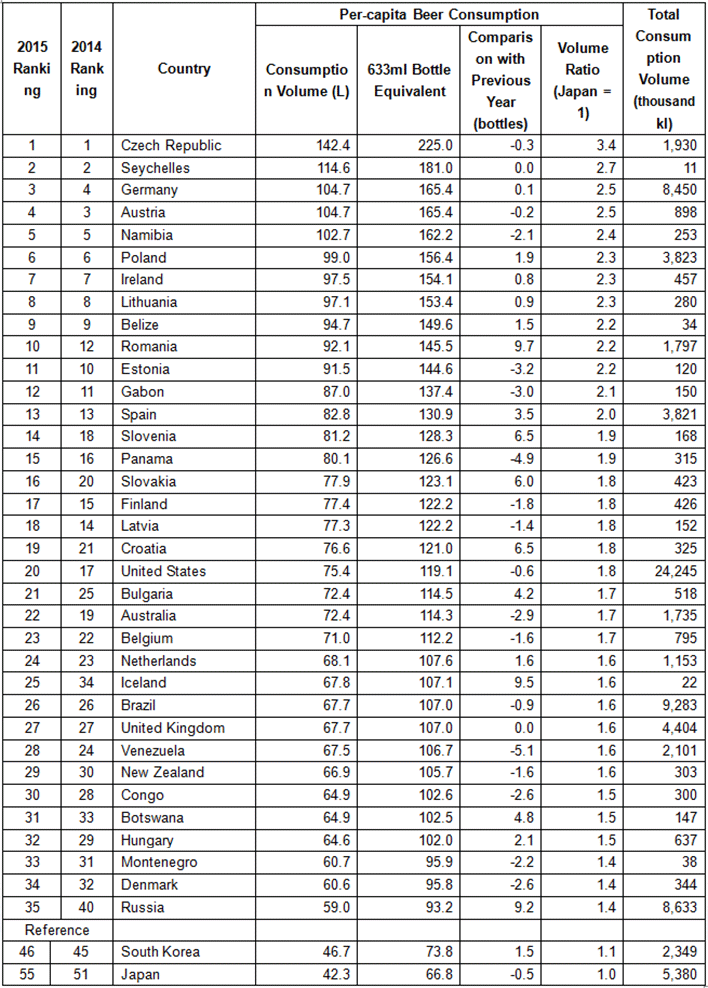- Home
- Newsroom
- News Releases
- 2016
- Kirin Beer University Report Global Beer Consumption by Country in 2015

Kirin Beer University Report Global Beer Consumption by Country in 2015
Global Beer Consumption falls year-on-year for the first time in 30 years; Asia is top for 8th consecutive year.
Kirin Company, Limited (President and CEO: Yoshinori Isozaki; hereafter “Kirin”) operates the Kirin Beer University (http://www.kirin.co.jp/entertainment/daigaku/), a virtual university on the Internet which was established in July 2001 to promote the enjoyment of beer and deep knowledge about beer to consumers. With various faculties and facilities, consumers can learn about a variety of topics, ranging from the best way to drink delicious beer to other interesting facts about beer—24 hours a day, 365 days a year.
This report for 2015 publishes the details of global beer consumption in 171 major countries and regions. The report is based on findings obtained from questionnaires sent by Kirin to various brewers’ associations around the world, as well as the latest industry statistics available overseas. The data for global beer consumption has been tracked by Kirin since 1975.
Main Topics
- Global beer consumption reached approximately 183.78 million kiloliters in 2015, down 0.3% from the previous year, marking the first year-on-year decline in 30 years. This level of consumption is enough to fill up the Tokyo Dome about 148 times over.
- By country, China remained the largest beer-consuming country in the world for the 13th consecutive year, although its significant decrease of 3.9% in 2015 compared to the previous year caused the global consumption total to fall. Mexico, in 6th place, marked a 6.7% increase in beer consumption, maintaining growth for two years in a row.
- By region, Asia consumed 1.6% less beer in 2015 compared to 2014, but still holds a 34.4% share of the global beer market, remaining the world’s largest beer-consuming region for the 8th consecutive year. Beer consumption in Africa went up 2.0% from the previous year, marking its 5th year of growth.
In 2015, the global beer consumption decreased about 600,000 kiloliters (equivalent to 900 million 633ml bottles) to 183.78 million kiloliters, which is equivalent to approximately 290.3 billion 633ml bottles. In comparison with 2014, there was an annual decrease of 0.3%. The total volume of the global beer consumption is equivalent to about 148 Tokyo Domes, if the stadium was a beer mug with a capacity of about 1.24 million kiloliters.
1. Global Beer Consumption by Country in 2015 (Table 1)
- China remained the largest beer-consuming country in the world for the 13th consecutive year since 2003, despite a decrease of 3.9% compared to 2014.
- Among the world’s top 25 beer-consuming countries, Vietnam achieved the highest growth of 7.7%, moving up from 11th place to ninth.
- Japan was ranked seventh for the ninth consecutive year, consuming 0.5% less beer than 2014.
2. Global Beer Consumption by Region in 2015 (Table 2)
- Although beer consumption decreased in the regions of Asia, Europe, North America and Oceania, other regions saw an increase.
- Asia remains the world’s largest beer-consuming region for the eighth consecutive year, despite a decrease of 1.6% compared to the previous year. Although annual consumption increased in Vietnam (+7.7%), India (+5.7%), and South Korea (+2.5%), the decrease in China (-3.9%) resulted in the overall decrease.
- Beer consumption in Africa grew for the fifth consecutive year, with an annual increase of 2.0% in 2015.
3. Per-capita Beer Consumption by Country in 2015 (Table 3)
- Czech Republic remains the world’s top in per-capita beer consumption for the 23rd consecutive year.
- Among the top 35 countries, 16 saw an increase in consumption from 2014 to 2015.
- Japan—which consumed 42.3 liters of beer, the equivalent of 66.8 bottles (633ml), on a per-capita basis in 2015 (an annual decrease of 0.5 bottles)—ranked second in Asia after South Korea, which consumed 46.7 liters.
The Kirin Group remains committed to creating a new beverage culture side by side with our consumers, and fostering well-being and prosperity among people and societies.
Note: Consumption volume in Japan is a combination of beer, happo-shu (low-malt beer), and new genre (non-malt beer). Due to rounding, the figures may not necessarily add up.
Among the countries whose figures for the previous year were revised for this year’s report, the revised figures are used to calculate year-on-year changes.
- *The volume of global consumption for the previous year has been updated (revised from 189.06 million kiloliters to 184.38 million kiloliters).
Source: Questionnaires sent by Kirin to the brewers’ associations in major countries.
The Barth Report Hops 2014/2015 (BARTH−HAAS GROUP)
2016 Beer Market Insights Reports (Canadean Ltd.)
- *As of 2013, there has been a change in the industry statistics data source. Therefore, some of the data may not necessarily correspond with past reports.
Table 1: Global Beer Consumption by Country in 2015

Comments
- Global beer consumption in 2015 was approximately 183.78 million kiloliters, a decrease of 0.3% from the previous year, marking the first annual decrease in 30 years.
- China remains the largest beer-consuming country in the world for the 13th consecutive year since 2003. There was a 3.9% decrease in the annual beer consumption due to poor weather over the summer and declining sales of beer in mid- to high-range restaurants. On the other hand, there was an increase in the number of people who enjoyed alcohol at home, due to an increase in online sales of alcohol.
- In the United States (±0.0%) and United Kingdom (-0.7%), there was an increase in the consumption of craft beer and premium beer led by young adults seeking unique flavors and individualism. In particular, craft beer consumption in the United States has been strong, with the market share of craft beer rising to 12%.
- In Brazil, annual beer consumption decreased by 1.9% as a result of weakening sales after the 2014 Soccer World Cup and reduced purchase intention due to the increase in tax on beer.
- Beer consumption in Russia decreased, with 3.6% less beer consumed in 2015 compared to 2014, due to the deteriorating economy and tax increases.
- Japan’s ranking has remained unchanged for nine years in a row, although 0.5% less beer was consumed in 2015 compared to 2014 due to poor weather during the summer months—when beer consumption is at its peak—and a diversification of the consumer palate.
- Beer consumption increased in South Korea for the third consecutive year, with 2.5% more beer consumed in 2015 due to increased popularity of imported and premium beers and increased popularity of beer among young adults and women who prefer low-alcohol drinks.
Table 2: Global Beer Consumption by Region in 2015

Note: Consumption volume in Japan is a combination of beer, happo-shu (low-malt beer), and new genre (non-malt beer).
2015 Global Market Share of Beer Consumption by Region

Asia 34.4%
Europe 27.0%
Central and South America 15.4%
North America 14.3%
Africa 7.0%
Oceania 1.2%
Middle East 0.7%
Comments
- Annual beer consumption in Asia was the highest in the world for the eighth consecutive year, although there was a decrease of 1.6% from the previous year, with its global market share dropping to 34.4% from last year’s 34.9%.
- Asia remained at the top as Vietnam, India, and South Korea continued to be the main driving forces, with annual growth rates of 7.7%, 5.7%, and 2.5% respectively. However, consumption in China decreased by 3.9%, resulting in an overall decrease for the second consecutive year.
- Central and South America, ranking third, recorded an increase of 1.7% from the previous year, the second consecutive year of growth. This was led mainly by countries such as Mexico and Colombia, with increases of 6.7% and 6.2% respectively, despite Brazil’s decrease of 1.9%.
Table 3: Per-capita Beer Consumption by Country in 2015

Comments
- Czech Republic led all other nations in per-capita beer consumption for the 23rd consecutive year.
- Among the top 35 countries ranked by per-capita beer consumption, 16 increased consumption levels from 2014 to 2015.